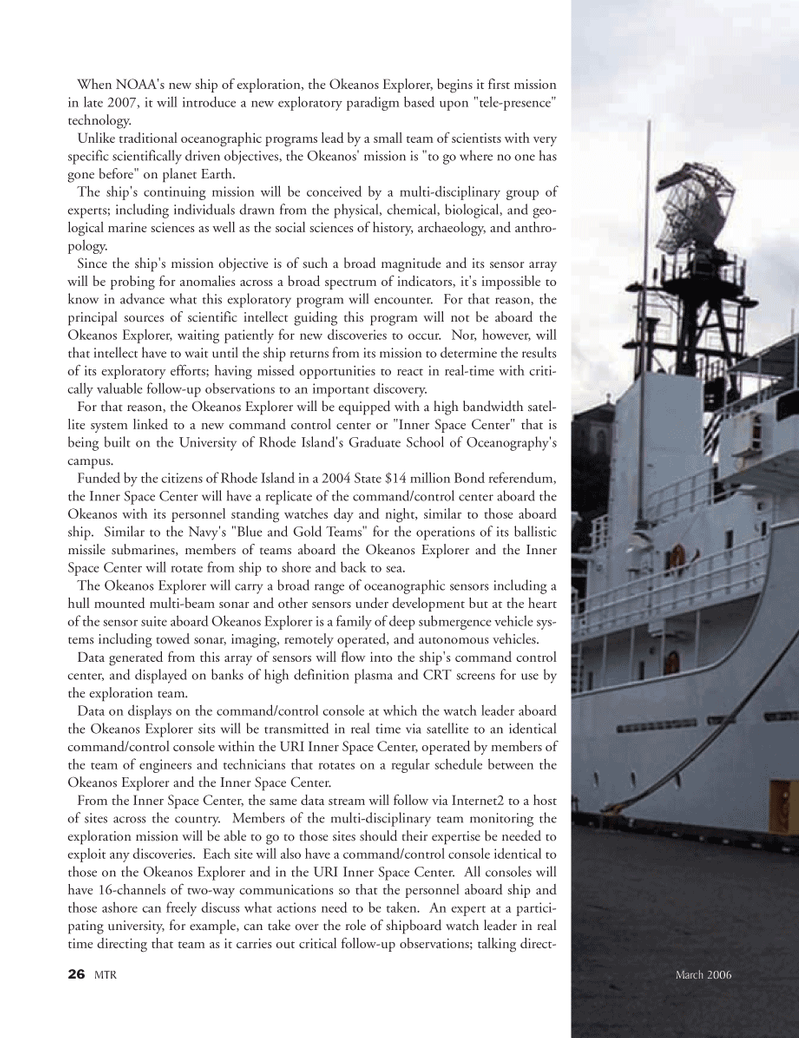
Page 25: of Marine Technology Magazine (March 2006)
AUVs; ROVs; UUVs
Read this page in Pdf, Flash or Html5 edition of March 2006 Marine Technology Magazine
When NOAA's new ship of exploration, the Okeanos Explorer, begins it first mission in late 2007, it will introduce a new exploratory paradigm based upon "tele-presence" technology.
Unlike traditional oceanographic programs lead by a small team of scientists with very specific scientifically driven objectives, the Okeanos' mission is "to go where no one has gone before" on planet Earth.
The ship's continuing mission will be conceived by a multi-disciplinary group of experts; including individuals drawn from the physical, chemical, biological, and geo- logical marine sciences as well as the social sciences of history, archaeology, and anthro- pology.
Since the ship's mission objective is of such a broad magnitude and its sensor array will be probing for anomalies across a broad spectrum of indicators, it's impossible to know in advance what this exploratory program will encounter. For that reason, the principal sources of scientific intellect guiding this program will not be aboard the
Okeanos Explorer, waiting patiently for new discoveries to occur. Nor, however, will that intellect have to wait until the ship returns from its mission to determine the results of its exploratory efforts; having missed opportunities to react in real-time with criti- cally valuable follow-up observations to an important discovery.
For that reason, the Okeanos Explorer will be equipped with a high bandwidth satel- lite system linked to a new command control center or "Inner Space Center" that is being built on the University of Rhode Island's Graduate School of Oceanography's campus.
Funded by the citizens of Rhode Island in a 2004 State $14 million Bond referendum, the Inner Space Center will have a replicate of the command/control center aboard the
Okeanos with its personnel standing watches day and night, similar to those aboard ship. Similar to the Navy's "Blue and Gold Teams" for the operations of its ballistic missile submarines, members of teams aboard the Okeanos Explorer and the Inner
Space Center will rotate from ship to shore and back to sea.
The Okeanos Explorer will carry a broad range of oceanographic sensors including a hull mounted multi-beam sonar and other sensors under development but at the heart of the sensor suite aboard Okeanos Explorer is a family of deep submergence vehicle sys- tems including towed sonar, imaging, remotely operated, and autonomous vehicles.
Data generated from this array of sensors will flow into the ship's command control center, and displayed on banks of high definition plasma and CRT screens for use by the exploration team.
Data on displays on the command/control console at which the watch leader aboard the Okeanos Explorer sits will be transmitted in real time via satellite to an identical command/control console within the URI Inner Space Center, operated by members of the team of engineers and technicians that rotates on a regular schedule between the
Okeanos Explorer and the Inner Space Center.
From the Inner Space Center, the same data stream will follow via Internet2 to a host of sites across the country. Members of the multi-disciplinary team monitoring the exploration mission will be able to go to those sites should their expertise be needed to exploit any discoveries. Each site will also have a command/control console identical to those on the Okeanos Explorer and in the URI Inner Space Center. All consoles will have 16-channels of two-way communications so that the personnel aboard ship and those ashore can freely discuss what actions need to be taken. An expert at a partici- pating university, for example, can take over the role of shipboard watch leader in real time directing that team as it carries out critical follow-up observations; talking direct- 26 MTR March 2006
MTR#2 (17-32).qxd 2/23/2006 5:03 PM Page 26

 24
24

 26
26
